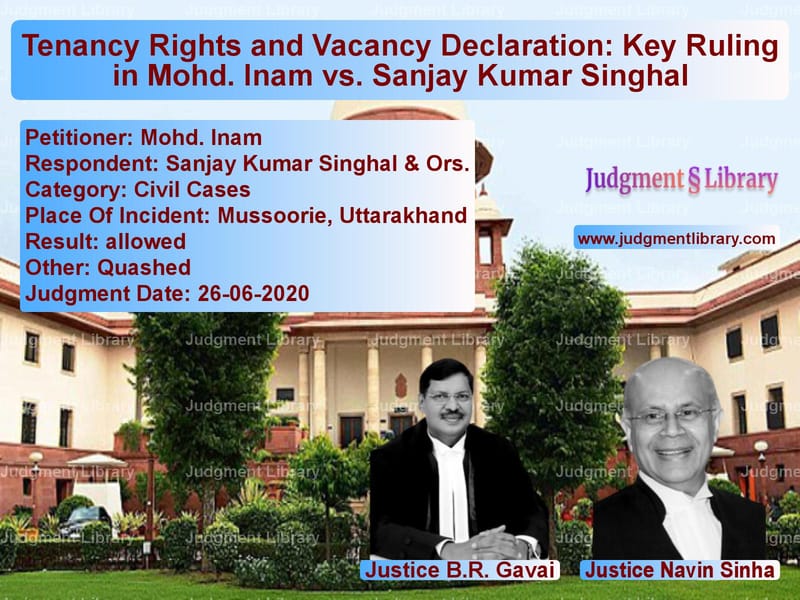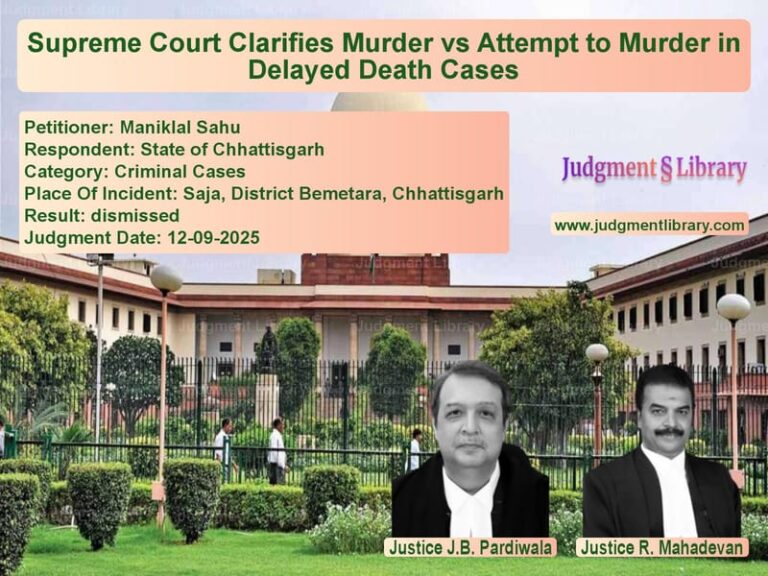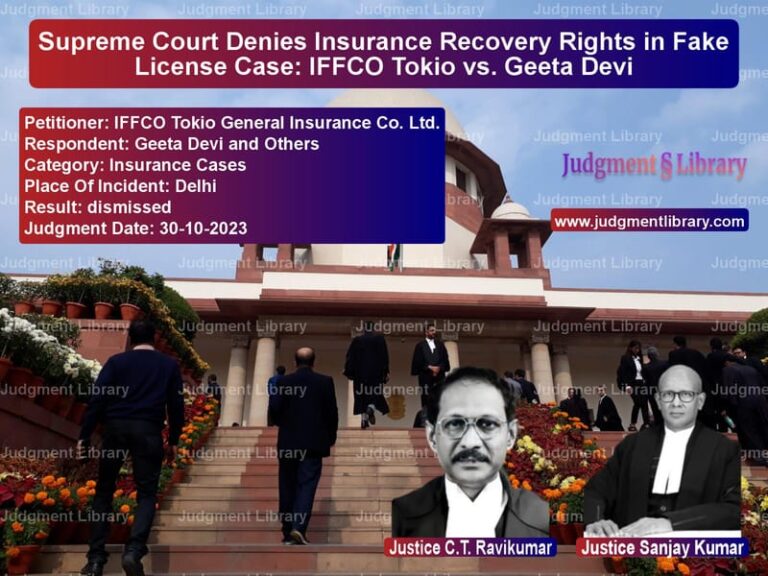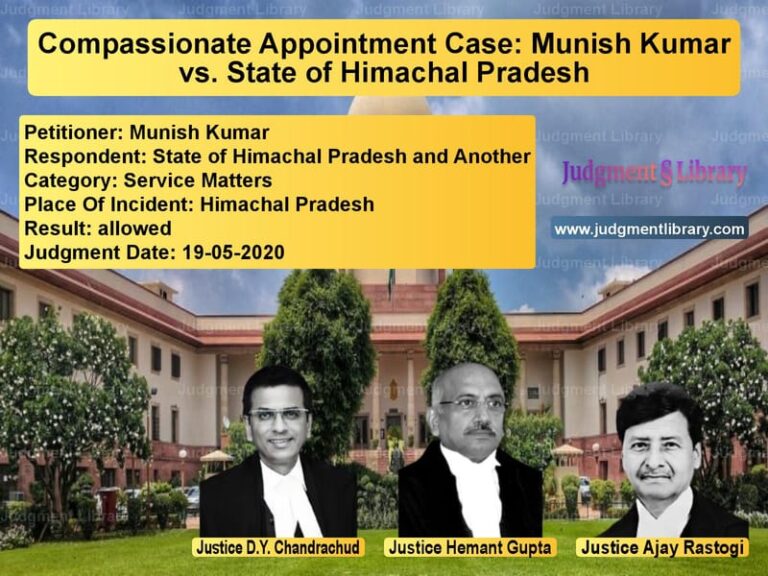Tenancy Rights and Vacancy Declaration: Key Ruling in Mohd. Inam vs. Sanjay Kumar Singhal
The case of Mohd. Inam vs. Sanjay Kumar Singhal & Ors. is a significant ruling by the Supreme Court of India concerning tenancy rights, eviction, and the interpretation of the U.P. Urban Buildings (Regulation of Letting, Rent, and Eviction) Act, 1972.
The Supreme Court had to determine whether the order of vacancy declared under the Act was legally valid and whether the revision order passed by the District Judge was appropriate.
The dispute originated from an eviction case where the landlord sought to reclaim the rented property, alleging subletting and unauthorized occupation. The case eventually reached the Supreme Court, which examined the legality of the lower court’s decisions.
Background of the Case
The appellant, Mohd. Inam, was the legal heir of Rashid Ahmed, who had been the tenant of House No. 61/8, Green Pasture View, Landhour Bazar, Mussoorie, since 1965.
The respondents purchased the property in 1998 and became the new landlords. They claimed that the original tenant, Rashid Ahmed, had sublet the premises to non-family members, violating the tenancy agreement.
The respondents filed an application before the Rent Controller and Eviction Officer, Mussoorie, under Section 16(1)(b) of the U.P. Urban Buildings (Regulation of Letting, Rent, and Eviction) Act, 1972, seeking a declaration of vacancy.
A Rent Control Inspector investigated the premises and submitted a report indicating that several persons were residing in the house, allegedly without legal tenancy rights.
Following the death of Rashid Ahmed in 2000, the appellant, Mohd. Inam, continued residing in the premises and contested the vacancy order. However, the Rent Controller declared the premises vacant on 4.6.2003.
The appellant challenged this order through a writ petition, which was initially dismissed, but he was granted the liberty to challenge the vacancy order along with the final order of allotment or release.
Legal Provisions and Key Issues
The case primarily involved the following legal provisions:
- Section 12(1)(b) of the U.P. Urban Buildings Act, 1972: This provision states that if a tenant allows unauthorized occupation by non-family members, the premises shall be deemed vacant.
- Section 16(1)(b): This section empowers the Rent Controller to declare a property vacant if illegal subletting is established.
- Section 18: It provides the right to file a revision against an order under Sections 16 or 19 on specific grounds such as lack of jurisdiction or material irregularity.
The Supreme Court had to determine:
- Whether the appellant was legally entitled to challenge the vacancy order in the revision petition along with the final order.
- Whether the High Court erred in holding that the revision petition before the District Judge was not maintainable.
- Whether the eviction order was justified based on the available evidence.
Arguments of the Petitioner
The petitioner, Mohd. Inam, argued the following:
- The Rent Control Inspector’s report was erroneous as all the occupants were family members and not unauthorized tenants.
- The judgment in Achal Misra vs. Rama Shanker Singh supported his right to challenge the vacancy order along with the final order.
- The High Court misinterpreted the law by stating that the revision petition against the vacancy order was not maintainable.
- The property was never sublet, and all occupants were either direct family members or part of the extended family, which did not violate tenancy laws.
Arguments of the Respondent
The respondent, Sanjay Kumar Singhal & Ors., presented the following arguments:
- The appellant’s family members were not original tenants and had no legal right to continue occupying the premises.
- The order of vacancy was passed based on a legally valid inspection report that indicated unauthorized occupation.
- The High Court correctly ruled that the revision petition against the vacancy order was not maintainable.
- The Rent Controller’s decision was based on factual evidence, and the appellant failed to produce any documents proving his right to tenancy.
Judgment of the Supreme Court
The Supreme Court analyzed the relevant legal provisions and previous judgments before delivering its verdict. The key findings of the Court were:
- The High Court erred in holding that the revision petition was not maintainable. The judgment in Achal Misra vs. Rama Shanker Singh explicitly allowed tenants to challenge vacancy orders along with final allotment orders.
- The Rent Control Inspector’s report did not provide clear evidence of subletting. The occupants were either direct family members or related to the original tenant.
- The term “allowed to be occupied” under Section 12(1)(b) requires that possession is handed over to a non-family member for independent occupation. This was not the case here.
- The appellant had the legal right to continue tenancy as the heir of the deceased tenant, and there was no evidence of rent being collected from other occupants.
- The District Judge correctly overturned the Rent Controller’s order, and the High Court wrongly interfered with a well-reasoned decision.
Accordingly, the Supreme Court allowed the appeal, set aside the High Court’s order, and reinstated the decision of the District Judge.
Impact of the Judgment
This landmark ruling has significant implications for tenancy laws in India:
- It clarifies that a tenant can challenge the vacancy order along with the final allotment order.
- It reinforces that mere residence by family members does not amount to illegal subletting.
- It sets a precedent for similar cases involving eviction disputes and inheritance rights in tenancy.
- It ensures that eviction proceedings must be based on strong evidence rather than mere assumptions of unauthorized occupation.
Conclusion
The judgment in Mohd. Inam vs. Sanjay Kumar Singhal & Ors. is a critical ruling in the interpretation of tenancy laws under the U.P. Urban Buildings (Regulation of Letting, Rent, and Eviction) Act, 1972.
The Supreme Court reaffirmed the rights of legal heirs in tenancy and clarified the process for challenging vacancy declarations.
This case highlights the importance of following due process in eviction proceedings and ensures that tenants are not unfairly deprived of their rights.
By setting aside the High Court’s decision, the Supreme Court upheld the principle that procedural fairness and substantive justice must guide tenancy disputes, preventing arbitrary eviction of long-term tenants.
This ruling will serve as a guiding precedent for future cases concerning tenancy, subletting, and inheritance rights in rented premises.
Petitioner Name: Mohd. Inam.Respondent Name: Sanjay Kumar Singhal & Ors..Judgment By: Justice B.R. Gavai, Justice Navin Sinha.Place Of Incident: Mussoorie, Uttarakhand.Judgment Date: 26-06-2020.
Don’t miss out on the full details! Download the complete judgment in PDF format below and gain valuable insights instantly!
Download Judgment: Mohd. Inam vs Sanjay Kumar Singhal Supreme Court of India Judgment Dated 26-06-2020.pdf
Direct Downlaod Judgment: Direct downlaod this Judgment
See all petitions in Landlord-Tenant Disputes
See all petitions in Property Disputes
See all petitions in Specific Performance
See all petitions in Judgment by B R Gavai
See all petitions in Judgment by Navin Sinha
See all petitions in allowed
See all petitions in Quashed
See all petitions in supreme court of India judgments June 2020
See all petitions in 2020 judgments
See all posts in Civil Cases Category
See all allowed petitions in Civil Cases Category
See all Dismissed petitions in Civil Cases Category
See all partially allowed petitions in Civil Cases Category







